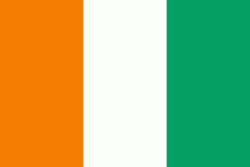Sassandra
Sassandra is a town in southern Ivory Coast. It is a sub-prefecture of and the seat of Sassandra Department. It is also a commune and the seat of Gbôklé Region in Bas-Sassandra District.
Sassandra lies on the Gulf of Guinea at the mouth of the Sassandra River. The town was founded by the Portuguese as Santo André and was later run by the British, then the French as a seaport for timber. The town declined in the 1960s after San Pédro's port was completed. Sassandra's main industry is now fishing.
Sassandra is known for its beaches and lighthouse, while the Gaoulou National Park lies nearby. It is served by Sassandra Airport.
In 2021, the population of the sub-prefecture of Sassandra was 87,945.
The thirty eight villages of the sub-prefecture of Sassandra and their population in 2014 are: • # Arokpa (363)
• # Bassa (492)
• # Batélébré 1 (94)
• # Brodjé (431)
• # Cocoplage (296)
• # Dabéda (169)
Sassandra lies on the Gulf of Guinea at the mouth of the Sassandra River. The town was founded by the Portuguese as Santo André and was later run by the British, then the French as a seaport for timber. The town declined in the 1960s after San Pédro's port was completed. Sassandra's main industry is now fishing.
Sassandra is known for its beaches and lighthouse, while the Gaoulou National Park lies nearby. It is served by Sassandra Airport.
In 2021, the population of the sub-prefecture of Sassandra was 87,945.
The thirty eight villages of the sub-prefecture of Sassandra and their population in 2014 are: • # Arokpa (363)
• # Bassa (492)
• # Batélébré 1 (94)
• # Brodjé (431)
• # Cocoplage (296)
• # Dabéda (169)
Map - Sassandra
Map
Country - Côte_d'Ivoire
 |
 |
| Flag of Ivory Coast | |
Before its colonization by Europeans, Ivory Coast was home to several states, including Gyaaman, the Kong Empire, and Baoulé. The area became a protectorate of France in 1843 and was consolidated as a French colony in 1893 amid the European Scramble for Africa. It achieved independence in 1960, led by Félix Houphouët-Boigny, who ruled the country until 1993. Relatively stable by regional standards, Ivory Coast established close political-economic ties with its West African neighbours while maintaining close relations with the West, especially France. Its stability was diminished by a coup d'état in 1999, then two civil wars—first between 2002 and 2007 and again during 2010–2011. It adopted a new constitution in 2016.
Currency / Language
| ISO | Currency | Symbol | Significant figures |
|---|---|---|---|
| XOF | West African CFA franc | Fr | 0 |
| ISO | Language |
|---|---|
| FR | French language |















